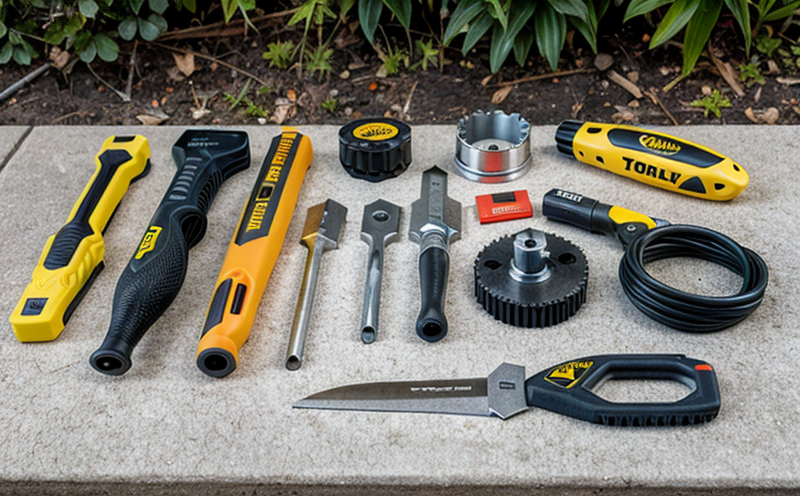Adhesion Testing of Paints on Hardware Surfaces
The adhesion testing of paints applied to hardware surfaces is a critical aspect of product safety and quality assurance in the consumer products sector. Hardware products, such as tools, handles, and fixtures, are often coated with paint for protection against corrosion, aesthetic appeal, or both. Ensuring that these coatings adhere properly can significantly enhance the durability and lifespan of the product.
Adhesion testing involves subjecting a painted surface to various mechanical stresses to assess how well the coating remains intact after exposure. This process is essential in determining whether the paint will withstand real-world conditions, including friction, abrasion, humidity, and temperature fluctuations.
The most common adhesion tests for paints on hardware surfaces include cross-hatch testing, tape stripping test, and pull-off adhesion test. Cross-hatch testing involves creating a series of cuts across the painted surface, which are then scored with progressively heavier loads until the paint begins to fail. Tape stripping is a simpler method where adhesive tape is applied to the surface, removed quickly, and the extent of paint removal evaluated.
The pull-off adhesion test utilizes a device that applies a specific force to a circular area on the painted surface. The force increases until the coating detaches from the substrate, at which point the amount of force required is recorded as an indicator of adhesion strength. This test can be performed according to international standards such as ISO 4628 and ASTM D3359.
In addition to these mechanical tests, other methods like immersion testing may also be employed to assess long-term durability in environments with varying humidity levels or exposure to chemicals that could affect the coating. It is crucial for manufacturers to conduct these tests rigorously to ensure compliance with relevant regulations and to improve product performance.
Understanding the specific hardware surface being coated is vital for accurate testing. Factors such as the type of metal, its thickness, and any underlying primers can influence adhesion properties. Proper specimen preparation also plays a significant role in achieving reliable results. This includes ensuring that the substrate is clean, dry, and free from contaminants before applying the paint.
Once the samples are prepared and tested, the data collected must be analyzed to determine if they meet industry standards or internal quality specifications. Reporting these findings accurately allows manufacturers to make informed decisions about product improvements or adjustments in their production processes.
Benefits
- Enhanced Product Durability: By ensuring strong adhesion between the paint and hardware surface, products are more resistant to wear and tear over time.
- Better Consumer Satisfaction: Products that last longer tend to be more reliable and appealing to consumers, leading to higher customer satisfaction rates.
- Regulatory Compliance: Adhering to adhesion testing standards helps manufacturers comply with relevant regulations, thereby avoiding potential legal issues or recalls.
- Cost Efficiency: Identifying weak points early in the development process can reduce costs associated with post-market failures and warranty claims.
Eurolab Advantages
At Eurolab, we specialize in providing comprehensive adhesion testing services for paints on hardware surfaces. Our team of experienced professionals uses cutting-edge technology and follows strict protocols to ensure accurate and reliable results.
We offer a wide range of testing methods tailored to meet the unique needs of your product. Whether you require basic cross-hatch or more advanced pull-off adhesion tests, we have the expertise to provide precise evaluations. Our state-of-the-art facilities are equipped with high-quality equipment that adheres strictly to international standards like ISO and ASTM.
Our commitment to quality is reflected in our certifications from leading industry bodies. This ensures that you receive consistent and accurate results every time, giving you peace of mind about the integrity of your products.
Environmental and Sustainability Contributions
Eco-friendly manufacturing practices are increasingly important in today's market. By conducting thorough adhesion testing on paints used for hardware surfaces, we help manufacturers identify sustainable alternatives that offer better performance without compromising environmental impact.
The use of advanced coatings not only enhances product longevity but also reduces the frequency of replacements needed, thus minimizing waste and resource consumption. This aligns directly with broader sustainability goals within industries focused on reducing carbon footprints and promoting circular economy principles.
Furthermore, our services contribute to reduced material usage by identifying optimal coating thicknesses that maintain necessary adhesion levels while minimizing excess paint application. This approach supports sustainable practices by optimizing resource efficiency throughout the product lifecycle.





